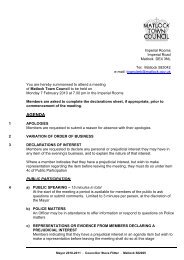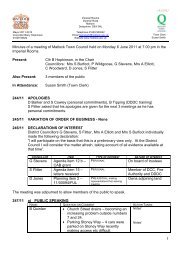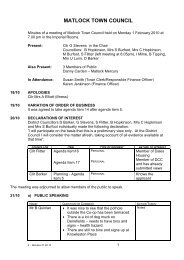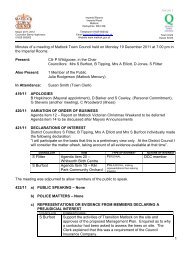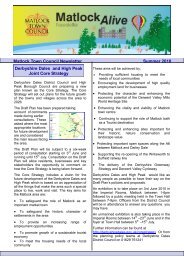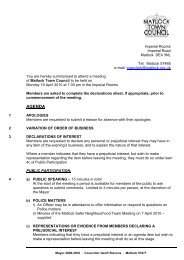Town Trails - Matlock Town Council
Town Trails - Matlock Town Council
Town Trails - Matlock Town Council
- No tags were found...
You also want an ePaper? Increase the reach of your titles
YUMPU automatically turns print PDFs into web optimized ePapers that Google loves.
MATLOCK -ITS HISTORY AND BACKGROUND<strong>Matlock</strong> BridgeRiber CastleIn 1848, <strong>Matlock</strong> town centre, as we see ittoday, did not exist. Apart from one or twobuildings near <strong>Matlock</strong> Bridge, therewere no properties at all along what isnow Dale Road. The north side of theriver, (presently occupied by Crown Square,lower Bank Road and Causeway Lane), wassimilarly largely free of any building,except for Bridge House (now incorporatedinto the <strong>Town</strong> Hall) and a smithy &adjacent property (long demolished)situated by the bridge at the edge of whatis now the Hall Leys Park. At that time,the nucleus of <strong>Matlock</strong> was in the vicinityof St Giles’ Church and Church Street (nowreferred to as Old <strong>Matlock</strong>), <strong>Matlock</strong> Greenand Knowleston Place.When the railway arrived from the southin 1849, the station was called <strong>Matlock</strong>Bridge. This heralded the beginning ofchange, but very slowly at first.Hydrotherapy (the treatment of illness bythe external application of water to thebody) was becoming fashionable at thetime. It fascinated the local textileentrepreneur John Smedley, who, havinghimself benefited from such treatment atBen Rhydding (in Yorkshire), opened asmall hydropathic hospital (hydro) at hisLea Bridge mill (near <strong>Matlock</strong>), formembers of his own workforce. It wouldappear that around the same time, a localman, Ralph Davis, opened a small hydroon <strong>Matlock</strong> Bank. In 1851, the two menjoined forces, but within two years,Smedley had bought out his partner.He already had the wealth. Perhaps healso had the vision to realise how his newventure could benefit from the proximityof the railway.Under the leadership of Smedley and hiswife, the establishment grew very rapidlyas wealthy clients from all over Englandcame to Smedley’s Hydro (as it wasknown) for treatment. Smedleyencouraged his ex-bathmen to open theirown smaller hydros to cater for the lesswell off. In addition, businessmen fromsurrounding towns began to invest in thisnew growth area. By 1898, there were2




